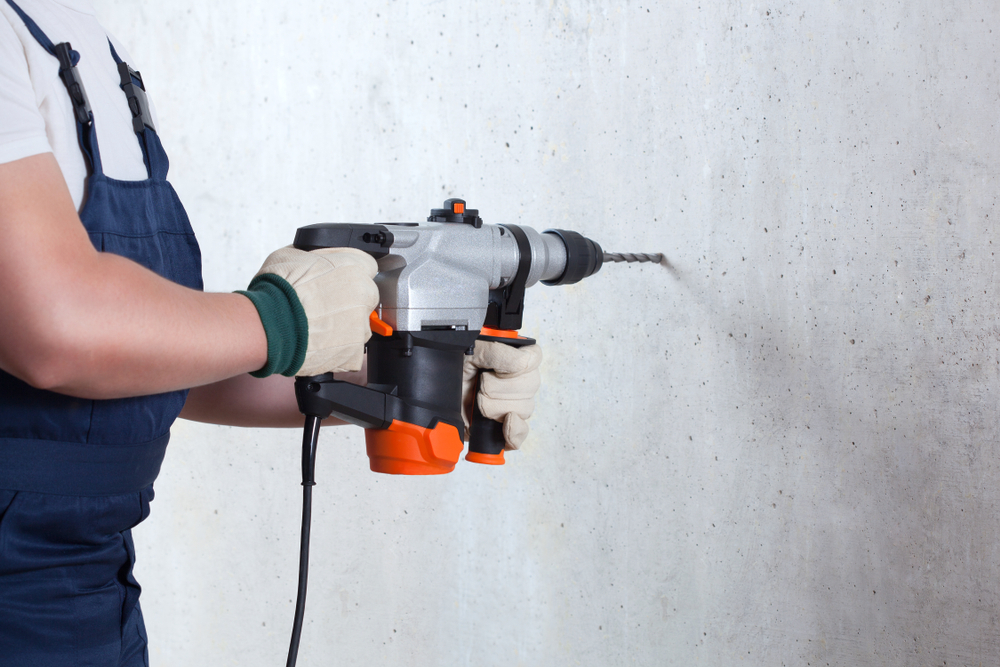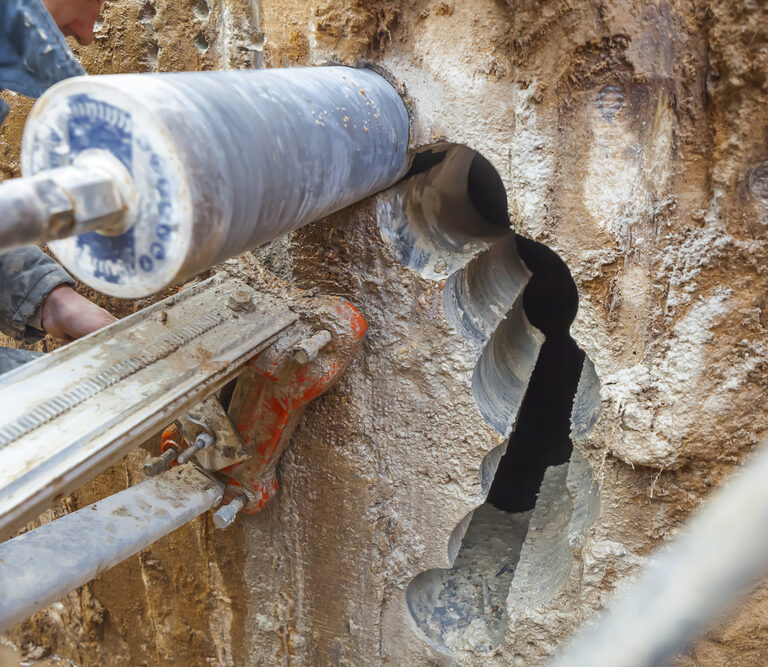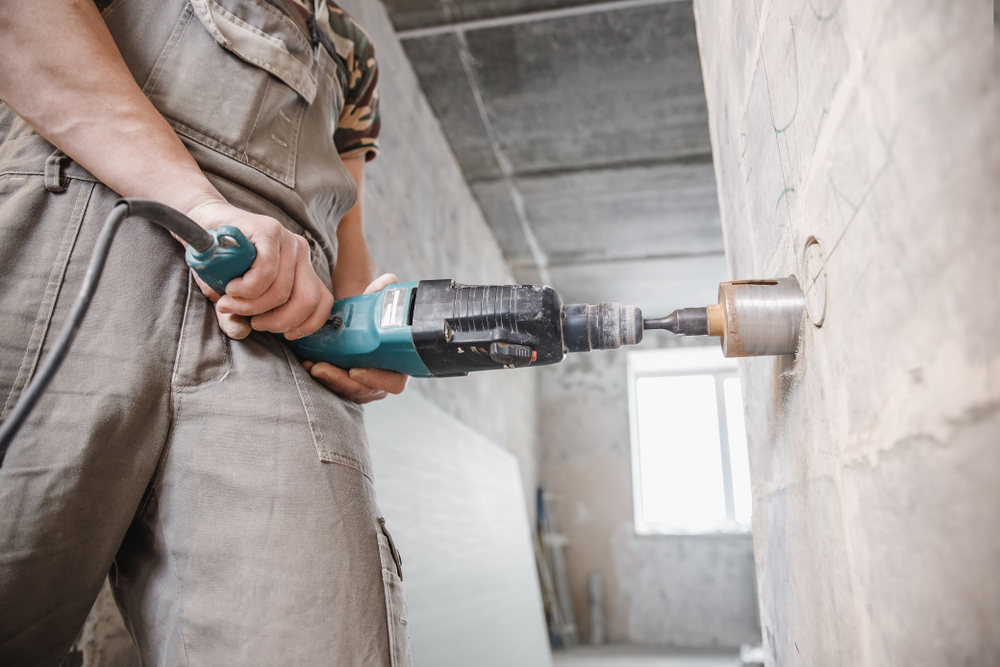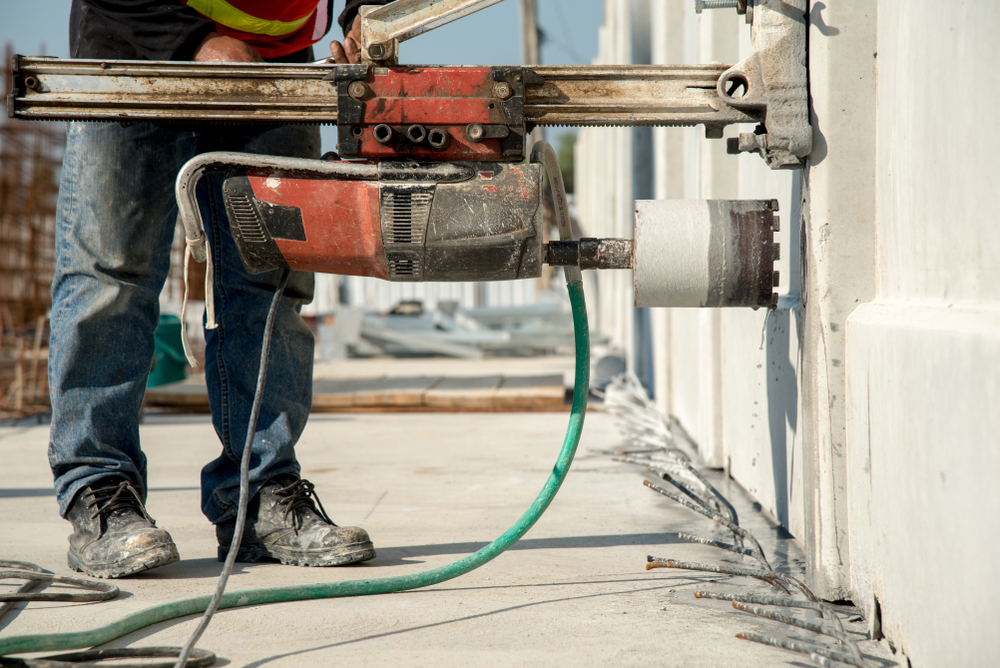There are a lot of reasons you might need to drill into concrete. You might install new hardware using Tapcons, drill holes for rebar to tie in a new slab, or core a hole for a new water pipe. However, drilling into concrete can seem like a really daunting task.
With the right tools, though, it’s something anyone can do. In this article, we’ll take a look at the best way to drill three different sizes of hole: small holes under half of an inch, medium holes up to three inches, and large holes over three inches in diameter
Drilling Small Holes in Concrete

Smaller holes are probably the most common holes drilled into concrete. If you have to anchor something to a slab or a block wall, you will probably use some kind of concrete shield. Those are rarely more than three-eighths of an inch in diameter.
The good news is that it’s such a common process; there are many inexpensive tools that can get the job done. In fact, if you own a modern battery-powered drill, you may have everything you need already.
Tools Needed
A hammer drill is really the only tool you need to drill a small hole into concrete. A larger, more powerful drill like this Dewalt is a great tool if you drill holes into concrete fairly often, but their battery-powered drill here is sufficient for the occasional hole.
Many drills that you get as part of a battery-powered combo kit have a hammer function, so take a look at the drill you already own, too. You may already have everything you need. Still, it’s almost always worth the money to invest in a more powerful drill when working with concrete.
The only other thing you might want is a vacuum. You can use the vacuum to suck up the dust as it exits the drilling location. That will save your lungs and keep your work area clean.
Bits Required
All you need is a standard masonry bit. If you have ever bought a big bit set that comes in a plastic case, chances are you already have a few. They look like a normal drill bit but have a flat spade on the tip instead of coming to a sharp point. That special tip does all the work; the spiral flutes are just to help remove material from the hole.
The only thing you need to be cautious of is that many hammer drills, rotary hammers, and demolition hammers require special bits that lock into the drill. If your drill doesn’t have a standard keyed or keyless chuck, you may need to search for bits that work with your specific tool.
A Note About Tapcons
Concrete screws, which many people call Tapcons because Tapcon is the largest manufacturer of concrete screws, have special rules for the bit you should use. Sometimes the bit comes in the box of screws, and you have nothing to worry about.
Otherwise, there should be a chart on the box that tells you what size bit to use. Often it’s 1/32 smaller than the shank, so a ¼” Tapcon needs a 9/32” concrete bit.
Preparation
You can prep for drilling small holes in concrete the same way you would prep for drilling holes in wood or other materials. Simply mark the location of the hole and make sure you have room to maneuver the tool.
If you are drilling for an anchor, a small plastic tool that holds screws, it can be helpful to wrap tape around the drill bit to mark the depth of the hole you want to create.
How to Drill the Hole
- Start slow; concrete bits are very prone to wandering as you apply pressure.
- Gradually add more pressure as the bit bites into the material. You shouldn’t press hard; let the tool do the work.
- Keep steady and direct pressure on the drill. Unlike other materials that have some give, if you bend and bind the bit in concrete, it will snap.
- Occasionally pull the drill back while holding the trigger. This will pull all the dust and debris out of the hole.
- When you reach the depth you want, keep the drill on while pulling it slowly out of the hole. That helps clear out the last bits of debris and ensures the hole’s uniformity.
Drilling Medium-Sized Holes in Concrete
Drilling a bigger hole in concrete requires bigger tools. The good news is that they are inexpensive to rent, and the rental shop will usually rent the bit along with the tool.
One of the most common reasons to drill ¾” holes in concrete is to tie in a new concrete slab. That means drilling holes into the existing concrete and epoxying in 6ft sections of rebar so that the new slab and the old slab are locked together.
Other Common Reasons Include:
- Setting large concrete anchors.
- Running small pipes or conduits.
- Drilling holes in a pattern for controlled demolition of the slab.
Tools Needed
There are two tools commonly used to drill medium-sized holes in concrete.
A larger hammer drill, like this Dewalt we mentioned above, is usually sufficient for drilling a few medium holes here and there. One of the main reasons you may need a bigger drill for these bigger holes is the chuck size. A smaller drill might have the power to drill a 1” hole, but it won’t be able to accept the bit shaft.
A rotary hammer is the hammer drills bigger sibling. It can generate a lot more force, and they often have a setting that stops the rotation, so you can use them as chisels. Rotary hammers tend to be more expensive than hammer drills, but if you do a lot of work with concrete, they are indispensable. The range in size so that they fit your job, from this smaller Dewalt to the industry-leading Bosch example here.
Bits Required
Like with the tools required, there are two main flavors of bit for drilling medium-sized holes in concrete.
Large masonry bits, like this monster 1 1/2” bit from Bosch, work just like their smaller counterparts. One of the biggest differences is that almost all of these larger bits have specialty shanks; they are not meant to work with a standard drill chuck.
Core cutter bits are sometimes called concrete hole saws and are a fairly new technology that resembles hole saws for wood. One of the nicest things about these newer bits, like this one from Binota, is that the cutting head is interchangeable. You can buy one set of cutters, and you’ll have the capability to drill a variety of different hole sizes.
Preparation
Prepping to drill a medium-sized hole isn’t much different than prepping for a small hole. You will need more space to work because the tool is larger, and it may help to have a level nearby so you can occasionally make sure you are drilling a straight hole.
You may also want to drill a pilot hole for bigger bits. If you drill a ¼” hole that’s an inch deep or so, the much bigger bits will be a lot easier to start because they can center on the pilot hole.
How to Drill the Hole
- Start slow; concrete bits are very prone to wandering as you apply pressure.
- Gradually add more pressure as the bit bites into the material. It’s especially important not to add too much pressure when using coring bits because you will risk breaking the teeth off if you press too hard.
- Keep steady and direct pressure on the drill. It is unlikely you will snap the larger bits, but it is even more important to keep the drill straight since these bigger holes are often much deeper. The worst-case scenario is that the bit can bend and become stuck in the concrete hole.
- Occasionally pull the drill back while holding the trigger. This will pull all the dust and debris out of the hole.
When you reach the depth you want, keep the drill on while pulling it slowly out of the hole. That helps clear out the last bits of debris and ensures the hole’s uniformity.
Drilling Large Holes in Concrete
Larger holes in concrete are trickier to drill than small or medium holes, and they require a lot more preparation. One of the biggest differences is that you will probably need a water hookup near the site you plan on drilling the hole.
Tools Needed
You may be able to drill a larger hole with a rotary hammer, but to really drill a big hole, you need a concrete core drill. There are smaller handheld ones, but the average coring tool looks like a drill press with a cartoonishly large bit. Some have to be anchored to the concrete to make a hole, so you’ll still need the rotary hammer too.
Two things separate a coring tool from a hammer drill. First, there is no hammer action. It’s just a big standard drill. Second, it uses water to cool the bit and carry the dust away as it grinds through the concrete.
It’s usually best to just rent these tools with the right bit for the job you need them for. You may be able to find inexpensive tools and bits. However, they are still fairly expensive and have very little extra functionality.
Preparation
The hardest part about using a coring tool is making sure you drill the hole where you want the hole to be drilled. How you do that will depend a lot on what style of coring tool you have at your disposal. You can watch this video from Hilti to get a good idea about the amount of setup involved.
Some coring tools are handheld and don’t use the drill press design. One of the best things you can build to help you is a hole template if you are using a handheld tool. Use some scrap ¾” plywood and drill a hole with the same diameter as the hole you will bore into the concrete. You can then stand on the template and use it to help hold the bit straight as you drill.
How to Drill the Hole
The drilling process varies a bit depending on the style of coring tool you have. You will need to consult the owner’s manual or talk to the company to get the proper instructions for the specific tool. One advantage of renting the tool is that the rental shop can teach you how to use it in person.
There are a handful of tips that we can give you to make the process easier no matter what kind of tool you have, though.
- A coring tool can cut right through rebar and rock just as easily as it cuts through concrete, so it’s incredibly important to know your drilling depth and what could be on the other side of the material.
- The amount of pressure needed will vary as you drill down. If you are using a coring tool without a base, you may find that you need to use your entire body weight to keep enough pressure on the tool to make an accurate hole.
- Drilling a smaller hole first and then coring around the hole will give you a place to stick a chisel so you can break the core out after you drill.
- Be careful breaking out the core if you didn’t first drill a hole or if you are drilling into a finished surface. The edges around the cored hole can be brittle.
Keep Boring Boring
Concrete is an amazing substance, and it takes some serious science to punch a hole in it. We hope that you now feel like you are capable of tackling that process. Just be sure to stay safe. Wear gloves, safety glasses, and a mask so that when you are boring a hole into concrete, it doesn’t get too exciting for you.


